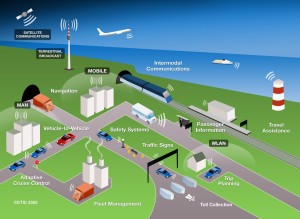Readers Benn and Mike agree with others who’ve commented on the questionable accuracy of the article posted earlier today from Talking Points Memo. Most likely, Toyota’s autonomous vehicle technology system is not based on shortwave (or high frequency) technology. Benn writes:
What may have happened is that Toyota’s media people confused Short Range with Short Wave. Officially the 5.9 GHz system they referred to is called Dedicated Short Range Communications (DSRC). That’s what the FCC named it when they allocated that band.
The FCC is into dry technical facts and not marketing. DSRC is too geek of a term. The government had to come up with a name that sounded more 21st Century, like Apple invented it or something. So it’s now the awesome Dept of Transportation Service Mark called IntelliDrive.
The irony is that an autonomous vehicle system must rely on near-range, or short-range communications; anything long-range wouldn’t make a lot of sense.
It’s too bad it’s not shortwave–! Don’t get me wrong, shortwave isn’t suited to this use. But I like to imagine how good propagation and band openings might affect road traffic. (Perhaps a car in Seattle would tell one in New York local driving conditions???) Plus, on a more serious note, if a vital first-world technology relied heavily upon HF communications, perhaps proper regulations would be put in place to protect our spectrum from the copious amounts of locally-generated RFI we deal with daily…Oh, it’s fine to dream.


Of course, when CB first came along, shortly after WWII, it was up in the 450MHz band, because there was no blank space lower in frequency. It didn’t take off, the UHF range meant equipment was expensive and/or not very good.
So in 1958, the FCC in the US took the 11Metre ham band and turned it into the CB band. And the problem was soon obvious. It was intended as a local medium, but when the band opened (and it did), it suffered from all kinds of signals coming from elsewhere in the country. A lot of the problems with CB came from that HF allocation. It made it too tempting to use it to try to talk to distant stations, but even if that wasn’t happening, there was too much interference when conditions were good.
FRS and GMRS has taken over, and the 450MHz allocation, now made cheap and useful with better solid state equipment, is much more suitable for what the band is good for.
In the beginning the lower frequencies were seen as most useful, a hundred years ago even shortwave was deemed “useless” and then slowly shown to be useful.
But then as times changed, shortwave became less valuable. A lot of services were actually local, and as equipment improved higher frequencies became more feasible. With satellites, even distant communication shifted from SW to UHF or microwave, all those ships at sea and I’m sure long distance communication to airplanes. The ham bands have expanded in the SW range as other services have moved up in frequency, while the VHF and higher allocations have been reduced. So much use for radio is short range that the much higher frequencies have become much more valuable.
Michael